Celebrating King's Day in Amsterdam
Should you visit Amsterdam only once, ensure your visit coincides with King's Day.
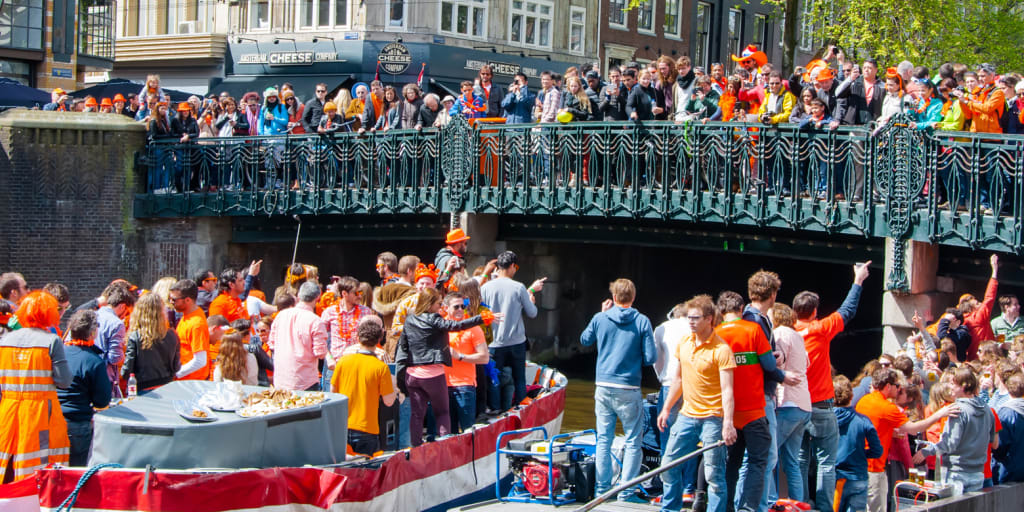
The King's Day national holiday commemorates the birthday of the King of the Netherlands on 30th April and serves as a symbol for patriotism and national unity. The night before King's Day is also celebrated in some Dutch cities. Keeping with convention, it’s known as King's Night and the largest of these celebrations takes place in Amsterdam where many of the restaurants, bars and clubs will remain open throughout the night.
The tradition began in August 1885 on the birthday of Princess Wilhelmina, who later became Queen Wilhelmina. After the ascension of Queen Juliana in 1949, the annual celebration shifted to commemorate her birthday. Today, the occasion marks the day when Queen Beatrix abdicated and was succeeded by her son – the current King regnant of the Kingdom of the Netherlands, King Willem-Alexander, on 27th April 2013.
However, the whole holiday all begins with King's Night. The city of Amsterdam has been in preparation for weeks: restaurants everywhere are fully booked, parties are planned and decorations adorn the streets. Even the little designated territories for each residence for the market the next day can be seen already marked out in chalk on the pavement.
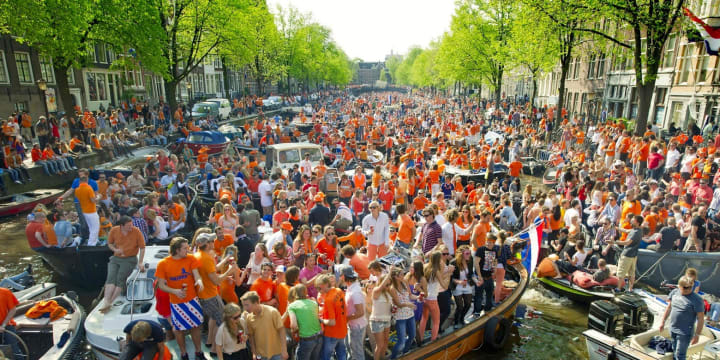
The festivities can be seen in full swing even on the canals that run through the city centre
Then, as the last working day before the holiday finally comes to a close, and like a line-up of athletes ready to surge forth at the sound of the starting gun…the celebrations of King's Night begin. Typically the evening will begin with a nice meal in one of the very busy restaurants. Most take bookings, but some do not. However, it would be wise to make reservations as far in advance as possible.
If you’re new to Amsterdam, the Jordaan area is a great place to start the night. Not only is it resplendent in traditional 17th and 18th century architecture, it’s extremely close to the city centre and there are many good restaurants, bars, cafés and locations of historical interest, all within a very short walk.
Taking to the streets after dinner, you’ll witness a city come alive – a capital in full carnival mode. Each bar and club you’ll pass will have plenty of people inside, but they’re seldom so packed you can’t still squeeze in. One of many wonderful aspects of Amsterdam is that there is such a choice of venues to visit they don’t all fill up at once.
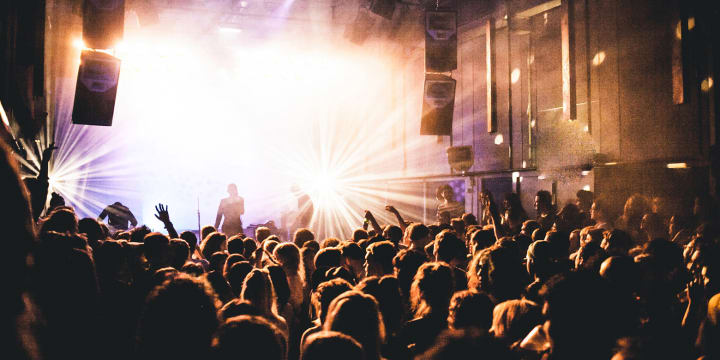
Trouw, on the Wibautstraat 131
Located on Prinsengracht, near the corner with Rozengracht between the Westerkerk and the Anne Frank House is a restaurant called Werck. The atmosphere here is electric and many gather in large groups or even just in couples to soak up the surroundings and enjoy the food. The venue later turns into a nightclub and is extremely popular with the locals.
Club culture is big in Amsterdam and one of the most popular sensations on the scene is a venue called Trouw, on the Wibautstraat 131, conceived by the creators of a number of Amsterdam’s popular nocturnal haunts. Admission is €15 and the dance music played here is a healthy mix of all things house.
King's Day is probably most famous for its ‘freemarket’ where, all over the country, everybody is allowed to sell absolutely anything in the streets. Owing to a holiday dispensation from the Dutch government, the indigenous population don’t need to pay taxes on anything they sell. As a result, outside almost every single residence, laid out on their ‘patch’ on a table or trestle or even on a blanket on the ground, is an assortment of just about everything you could possibly imagine.
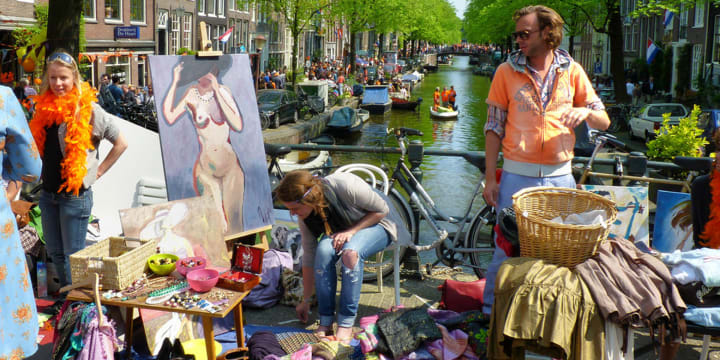
King's Day is probably most famous for its freemarket, where anybody can sell anything
Any unwanted or unused jumble, old toys, hand-me-downs, anything hand-made or hand-crafted, cutlery, kitchenware or knitwear will be on display and on sale for no more than a Euro or two. It is, in essence, a country-sized car boot sale.
Depending how much sleep you did or didn’t get on King's Night, the gentle pace of slowly patrolling the freemarket-filled streets the next day perfectly suits anyone still feeling slightly fragile. There’s plenty to see and no rush whatsoever. It’s also an opportunity for any budding entrepreneurs to sell snacks, home-cooked food, or even offer a comfortable seat and a welcome coffee – as there’s a lot of ground to cover. The city centre is completely closed to traffic for this holiday and the streets are instead filled with people slowly sauntering through, browsing at their leisure.
Prices are usually negotiable and a little bartering is expected, but the prices will also drop as the day progresses, should you risk postponing a potential bargain – and bargains can be found. By the end of the day’s festivities much of the unsold merchandise is left on the streets to be picked through until it’s hauled off by local municipalities.
The main streets are gradually being taken over by commercial market stalls pushing the amateur flea market traders out towards smaller streets and the outer ring of the centre, but there are, however, many areas where the original style is preserved.
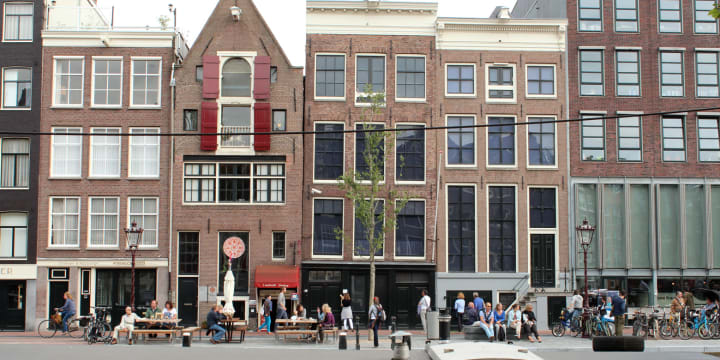
Amsterdam is piled high with history, the Anne Frank House on the Prinsengracht is just one example
One of these is the De Wallen, a gentrified former working-class neighborhood, where prices are still low because the market is just an excuse to have a nice day and a friendly chat with complete strangers. Sections of the De Wallen can become so full of pedestrians that they become completely gridlocked, despite the absence of cars.
Another is the Vondelpark, which is officially reserved for children. Here you’ll find many other attractions and amusements besides the market, including live music, fairground rides and funfair-style sidestalls that offer games testing skill, strength, luck and occasionally aim.
The canals that crisscross the city centre are filled with boats, which in turn are filled with people…almost to the point where they look like they might sink. Yet despite the risk of a maritime mishap, everyone looks like they are having the time of their life. Each little boat is having its own little party.
In keeping with true Dutch tradition, everyone wears at least one item that’s orange, others kit themselves out from head to toe. Sometimes called the ‘orange craze’ or ‘oranjegekte’ in Dutch, this is a reference to the colours of the House of Orange-Nassau – a branch of the European House of Nassau, which has played a central role in the political life of the Netherlands since the 16th century. Consequently, it has been adopted as the national colour of Holland, very much like the sea of green found anywhere Irish on St Patrick’s Day.
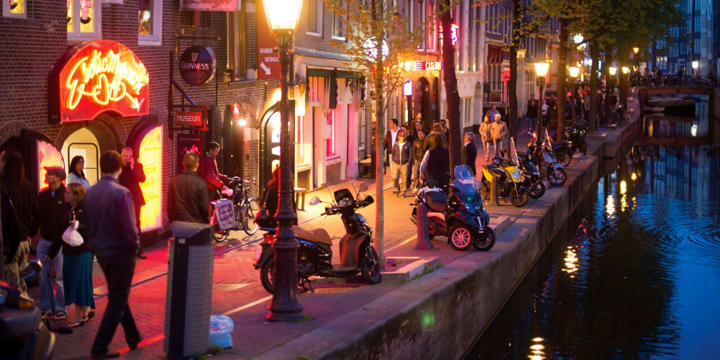
The Jordaan area includes Amsterdam's infamous red light district
Amsterdam is positively piled high with history, the Anne Frank House on the Prinsengracht, is a classic example. The house is now a museum dedicated to Jewish wartime diarist Anne Frank, who hid from Nazi persecution with her family and four other people in hidden rooms at the rear of the building, which have been preserved.
Another is the Van Gogh museum. It contains the largest collection of paintings by Vincent Van Gogh in the world and chronicles the phases of Van Gogh’s life, from his childhood to his various emotional stages through to his death. The main exhibition highlights include ‘The Potato Eaters’, ‘Bedroom in Arles’ and one of two ‘Vase with 15 Sunflowers’. The museum also offers exhibitions on various subjects from 19th century art history. It’s located on Museumplein, between the Rijksmuseum and the Stedelijk Museum. The entrance is at Paulus Potterstraat 7.
The city of Amsterdam fans out south from the Central railway station. The Damrak is the main street and leads into the street Rokin. The oldest area of the town is known as de Wallen. It lies to the east of Damrak and contains the city’s famous red light district.
Like every European capital, there’s a wide choice of accommodation on offer, ranging from hostels to hotels. One hotel, with spectacular views of the IJ River is the Mövenpick, located in the area known as the Eastern Docklands. It’s a little more on the expensive side, but it’s extremely easy to get to by road and every taxi driver knows exactly where it is: extremely useful when you’re stumbling out of a club at five o’clock in the morning.
About the Creator
Scott Snowden
Writer, editor, caffeine based life-form.


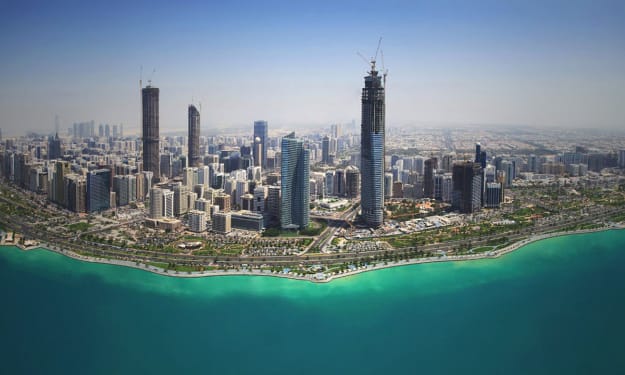



Comments
There are no comments for this story
Be the first to respond and start the conversation.